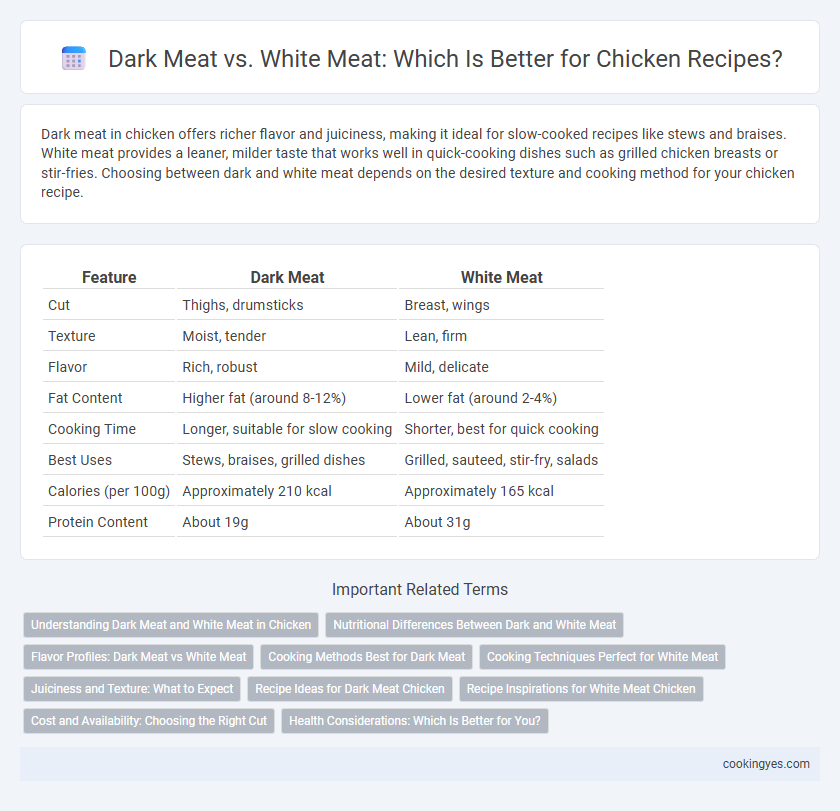Dark meat in chicken offers richer flavor and juiciness, making it ideal for slow-cooked recipes like stews and braises. White meat provides a leaner, milder taste that works well in quick-cooking dishes such as grilled chicken breasts or stir-fries. Choosing between dark and white meat depends on the desired texture and cooking method for your chicken recipe.
Table of Comparison
| Feature | Dark Meat | White Meat |
|---|---|---|
| Cut | Thighs, drumsticks | Breast, wings |
| Texture | Moist, tender | Lean, firm |
| Flavor | Rich, robust | Mild, delicate |
| Fat Content | Higher fat (around 8-12%) | Lower fat (around 2-4%) |
| Cooking Time | Longer, suitable for slow cooking | Shorter, best for quick cooking |
| Best Uses | Stews, braises, grilled dishes | Grilled, sauteed, stir-fry, salads |
| Calories (per 100g) | Approximately 210 kcal | Approximately 165 kcal |
| Protein Content | About 19g | About 31g |
Understanding Dark Meat and White Meat in Chicken
Dark meat in chicken, found primarily in the legs and thighs, contains higher fat content and myoglobin, giving it a richer flavor and juicier texture ideal for slow-cooked and roasted recipes. White meat, located in the breast and wings, is lower in fat and has a milder taste, making it suitable for quick cooking methods like grilling or sauteing to maintain tenderness. Understanding the differences in moisture and protein levels between dark and white meat helps optimize cooking techniques and enhances the overall flavor profile of chicken dishes.
Nutritional Differences Between Dark and White Meat
Dark meat in chicken contains higher levels of fat and calories compared to white meat, making it richer in iron, zinc, and B vitamins such as B6 and B12. White meat is leaner, lower in fat and calories, and provides a higher protein content per serving, which supports muscle repair and growth. These nutritional differences influence recipe choices, with dark meat suited for slow-cooked, flavorful dishes and white meat preferred for lighter, quick-cooking meals.
Flavor Profiles: Dark Meat vs White Meat
Dark meat in chicken, found primarily in the thighs and drumsticks, offers a richer, more intense flavor due to its higher fat content and myoglobin levels, making it ideal for slow-cooked or marinated recipes that highlight its juiciness and depth. White meat, including the breast and wings, features a milder taste and leaner texture, which works well in dishes requiring quick cooking methods or delicate seasoning to preserve its subtle flavor. Understanding the distinct flavor profiles of dark and white meat allows chefs to tailor recipes for optimal taste and texture balance.
Cooking Methods Best for Dark Meat
Chicken dark meat, consisting of thighs and drumsticks, is rich in fat and collagen, making it ideal for slow cooking methods like braising, roasting, and stewing. These techniques enhance the tenderness and juiciness of the meat, allowing the connective tissue to break down and impart deep flavors. Dark meat's higher fat content also makes it well-suited for grilling and frying, where it retains moisture better than white meat.
Cooking Techniques Perfect for White Meat
White meat chicken, such as breast and wings, benefits from quick cooking methods like grilling, sauteing, and baking to preserve its tenderness and prevent dryness. Using marinades or brining can enhance moisture retention and add flavor depth. Cooking at moderate temperatures with minimal cooking time ensures juicy and flavorful white meat in various chicken recipes.
Juiciness and Texture: What to Expect
Dark meat chicken, found primarily in the thighs and drumsticks, offers a higher fat content that results in juicier, more tender texture compared to white meat. White meat, from the breast and wings, is leaner with a firmer, drier texture but cooks faster, making it suitable for recipes requiring quick preparation. Expect dark meat to remain moist and flavorful during long cooking processes, while white meat benefits from careful cooking to avoid dryness.
Recipe Ideas for Dark Meat Chicken
Dark meat chicken, rich in flavor and higher fat content, offers succulent texture perfect for slow-cooked recipes like braised chicken thighs and coq au vin. Its natural juiciness makes it ideal for grilling, roasting, or incorporating into hearty stews and casseroles to enhance moisture and depth. Popular dishes include spicy chicken drumsticks, oven-baked leg quarters with herbs, and rich chicken curry using thigh meat for tender, flavorful results.
Recipe Inspirations for White Meat Chicken
White meat chicken, known for its tender texture and mild flavor, shines in recipes like grilled chicken breasts, stuffed chicken rolls, and creamy chicken Alfredo. Its lower fat content makes it ideal for health-conscious dishes, allowing it to absorb herbs, spices, and marinades effectively. Popular recipe inspirations include lemon herb chicken, chicken piccata, and chicken stir-fry, showcasing versatility in both quick weeknight meals and elegant dinner options.
Cost and Availability: Choosing the Right Cut
Dark meat chicken, comprising thighs and drumsticks, tends to be more affordable and widely available compared to white meat cuts like breasts, making it a budget-friendly choice for various recipes. Its higher fat content contributes to a richer flavor and moist texture, which suits slow-cooking methods commonly used in casseroles and stews. White meat, while leaner and preferred for quick cooking, often commands a higher price and may be less accessible in bulk purchasing, affecting meal planning decisions.
Health Considerations: Which Is Better for You?
Dark meat chicken contains higher levels of fat and calories compared to white meat, making it richer in flavor but less ideal for low-fat diets. White meat is leaner and provides a significant amount of protein with fewer calories, promoting heart health and weight management. Both types offer essential nutrients like B vitamins and iron, but choosing between dark and white meat depends on individual dietary goals and health conditions.
Dark Meat vs White Meat for Chicken Recipes Infographic

 cookingyes.com
cookingyes.com